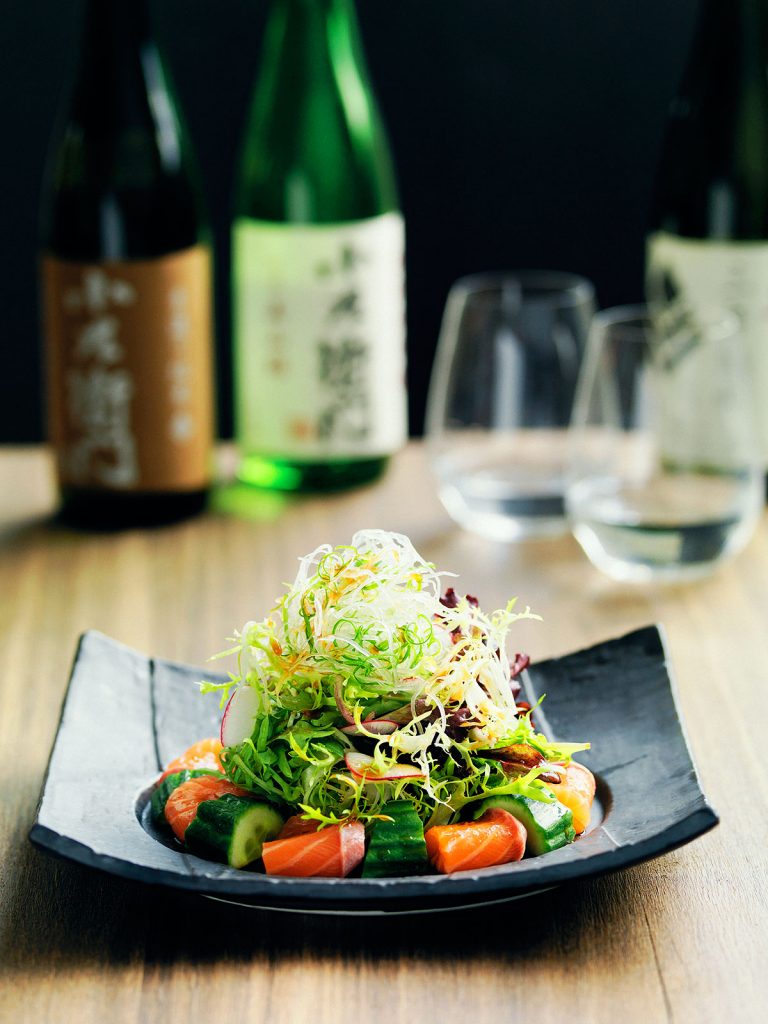Essentials dropped in to Saké Melbourne to explore menu items and premium sake presented by Chef Shaun Presland. Saké is easy to find: just aim for the cool new open-plan ‘cut-out’ built right into the side and base of Arts Centre Melbourne’s Hamer Hall. There’s plenty of space on two levels offering indoor and outdoor seating with Southbank riverside and city skyline views.
We sampled Saké’s white-soy shiromi (white fish): in this case beautifully clean, fresh slices of snapper topped with sesame seeds, chives, yuzu juice and white soy dressing. Softly textured – creamy with a sweet and slightly sour dressing, its flavours are balanced with the delicate nuttiness of sesame and just the right a touch of salt.
These quick bites were very gratefully washed down with fragrantly floral, pear-like Amabuki Daiginjo saké, beautifully made with a yeast starter derived from abelia (honeysuckle) petals. It’s silky soft on the palate, finishing long and well balanced. Both Amabuki brewery and Kozaemon brewery products are imported exclusively for Saké Restaurant and Bars Australia. (Kozaeman is particularly popular in Japan for its wide range of saké styles.)
Next up, alongside some well-presented wagyu tataki, the Kozaemon brewery’s Junmai Ginjo Shinano Miamanishiki organic saké, made with 55 percent polished rice is impressive, boasting rounder, deeper scents of melon, nashi pear and marzipan. (Polishing rice removes the outer layers of each grain. The percentages refer to the amount of the original grain that remains. As a rule, the higher the polish, the finer the rice and the resultant saké.)
The colourful aroma of the Shinano Miamanishiki is smooth and appealing yet also fat in its approach. On the palate it’s medium-bodied which works well with the wagyu tataki – simply dressed with garlic chips, ginger and soy. For my money, the less dressing the better as the beef is soft in texture and well flavoured. But perhaps I’m a touch too fussy, because those flavours are a brilliant match for the saké.
Taking it up a notch, the seamless: Kozaemon Junmai Daiginjo (50 percent rice polish), showcases an extremely delicate yet still floral and fragrant nose, now with added citrus. In this case, the fruit fragrances don’t overpower the cleanness and aromas of the rice. It is a beautiful saké to continue swirling and smelling; its palate is extremely refined, featuring a much longer, almost whisky-like ‘warming’ length to its finish. There’s nothing sharp here, no nasties – it’s a seamless saké from front to back palate.
Different in style again is the Kozaemon Junmai Ginjo Sakura saké, slightly cloudy in colour (a little like cloudy apple juice), started with cherry blossom yeast and made especially for Saké Restaurants and Bars. It offers a completely different experience with fuller, sweeter fragrances and more granular ground-rice texture. It is bigger, and heavier in palate weight and a good match for more filling bites such as wagyu croquettes with softly smoked carrot puree and teriyaki sauce from Saké’s a la carte menu.
But it’s not all white fish and beef strips: Saké also delivers some smart sweet stuff. We admire the presentation of the white chocolate mousse and green tea ‘KitKat’. With a clever maze-shaped design of white chocolate mousse sculpted on top of each KitKat-inspired wedge, the whole dish is a colourful and playful experience. Fresh fruits, cherry jelly, mint leaves and an awesome Earl Grey tea ice-cream accompany the layered dark chocolate and almond, green tea and white chocolate mousses.
In terms of design, texture and flavour this dessert is a standout. The Earl Grey tea ice-cream is a fav, as is the Choya Kokuto, a great umeshu from Osaka. Umeshu is a Japanese liqueur made by steeping ume fruits (Japanese plums) in alcohol and sugar while still unripe and green.
Choya Kokuto is made with ume fruit, brown sugar, black rum, and black vinegar. It’s served with ice and a sweet, ‘drunk’ green plum, creating an after-dinner digestive to give the Italians a serious run for their money.
Saké Restaurant and Bar represents extremely good value for money and quality choices. Though a bottle of superior Junmai Ginjo rice saké might set you back $65-$109, we suggest you’ll appreciate the experience.



Comments are closed.